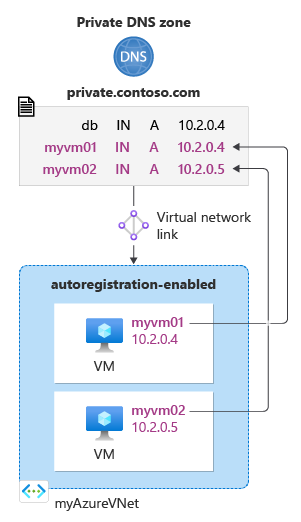Quickstart: Create an Azure private DNS zone using the Azure CLI
This quickstart walks you through the steps to create your first private DNS zone and record using the Azure CLI.
A DNS zone is used to host the DNS records for a particular domain. To start hosting your domain in Azure DNS, you need to create a DNS zone for that domain name. Each DNS record for your domain is then created inside this DNS zone. To publish a private DNS zone to your virtual network, you specify the list of virtual networks that are allowed to resolve records within the zone. These are called linked virtual networks. When autoregistration is enabled, Azure DNS also updates the zone records whenever a virtual machine is created, changes its' IP address, or is deleted.
If you don't have an Azure subscription, create an Azure free account before you begin.
Prerequisites
Use the Bash environment in Azure Cloud Shell. For more information, see Quickstart for Bash in Azure Cloud Shell.
If you prefer to run CLI reference commands locally, install the Azure CLI. If you're running on Windows or macOS, consider running Azure CLI in a Docker container. For more information, see How to run the Azure CLI in a Docker container.
If you're using a local installation, sign in to the Azure CLI by using the az login command. To finish the authentication process, follow the steps displayed in your terminal. For other sign-in options, see Sign in with the Azure CLI.
When you're prompted, install the Azure CLI extension on first use. For more information about extensions, see Use extensions with the Azure CLI.
Run az version to find the version and dependent libraries that are installed. To upgrade to the latest version, run az upgrade.
- You can also complete this quickstart using Azure PowerShell.
Create the resource group
First, create a resource group to contain the DNS zone:
az group create --name MyAzureResourceGroup --location "East US"
Create a private DNS zone
The following example creates a virtual network named myAzureVNet. Then it creates a DNS zone named private.contoso.com in the MyAzureResourceGroup resource group, links the DNS zone to the MyAzureVnet virtual network, and enables automatic registration.
az network vnet create \
--name myAzureVNet \
--resource-group MyAzureResourceGroup \
--location eastus \
--address-prefix 10.2.0.0/16 \
--subnet-name backendSubnet \
--subnet-prefixes 10.2.0.0/24
az network private-dns zone create -g MyAzureResourceGroup \
-n private.contoso.com
az network private-dns link vnet create -g MyAzureResourceGroup -n MyDNSLink \
-z private.contoso.com -v myAzureVNet -e true
If you want to create a zone just for name resolution (no automatic hostname registration), you could use the -e false parameter.
List DNS private zones
To enumerate DNS zones, use az network private-dns zone list. For help, see az network dns zone list --help.
Specifying the resource group lists only those zones within the resource group:
az network private-dns zone list \
-g MyAzureResourceGroup
Omitting the resource group lists all zones in the subscription:
az network private-dns zone list
Create the test virtual machines
Now, create two virtual machines so you can test your private DNS zone:
az vm create \
-n myVM01 \
--admin-username AzureAdmin \
-g MyAzureResourceGroup \
-l eastus \
--subnet backendSubnet \
--vnet-name myAzureVnet \
--nsg NSG01 \
--nsg-rule RDP \
--image win2016datacenter
az vm create \
-n myVM02 \
--admin-username AzureAdmin \
-g MyAzureResourceGroup \
-l eastus \
--subnet backendSubnet \
--vnet-name myAzureVnet \
--nsg NSG01 \
--nsg-rule RDP \
--image win2016datacenter
Creating a virtual machine will take a few minutes to complete.
Create an additional DNS record
To create a DNS record, use the az network private-dns record-set [record type] add-record command. For help with adding A records for example, see az network private-dns record-set A add-record --help.
The following example creates a record with the relative name db in the DNS Zone private.contoso.com, in resource group MyAzureResourceGroup. The fully qualified name of the record set is db.private.contoso.com. The record type is "A", with IP address "10.2.0.4".
az network private-dns record-set a add-record \
-g MyAzureResourceGroup \
-z private.contoso.com \
-n db \
-a 10.2.0.4
View DNS records
To list the DNS records in your zone, run:
az network private-dns record-set list \
-g MyAzureResourceGroup \
-z private.contoso.com
Test the private zone
Now you can test the name resolution for your private.contoso.com private zone.
Configure VMs to allow inbound ICMP
You can use the ping command to test name resolution. So, configure the firewall on both virtual machines to allow inbound ICMP packets.
Connect to myVM01, and open a Windows PowerShell window with administrator privileges.
Run the following command:
New-NetFirewallRule –DisplayName "Allow ICMPv4-In" –Protocol ICMPv4
Repeat for myVM02.
Ping the VMs by name
From the myVM02 Windows PowerShell command prompt, ping myVM01 using the automatically registered host name:
ping myVM01.private.contoso.comYou should see an output that looks similar to what is shown below:
PS C:\> ping myvm01.private.contoso.com Pinging myvm01.private.contoso.com [10.2.0.4] with 32 bytes of data: Reply from 10.2.0.4: bytes=32 time<1ms TTL=128 Reply from 10.2.0.4: bytes=32 time=1ms TTL=128 Reply from 10.2.0.4: bytes=32 time<1ms TTL=128 Reply from 10.2.0.4: bytes=32 time<1ms TTL=128 Ping statistics for 10.2.0.4: Packets: Sent = 4, Received = 4, Lost = 0 (0% loss), Approximate round trip times in milli-seconds: Minimum = 0ms, Maximum = 1ms, Average = 0ms PS C:\>Now ping the db name you created previously:
ping db.private.contoso.comYou should see an output that looks similar to what is shown below:
PS C:\> ping db.private.contoso.com Pinging db.private.contoso.com [10.2.0.4] with 32 bytes of data: Reply from 10.2.0.4: bytes=32 time<1ms TTL=128 Reply from 10.2.0.4: bytes=32 time<1ms TTL=128 Reply from 10.2.0.4: bytes=32 time<1ms TTL=128 Reply from 10.2.0.4: bytes=32 time<1ms TTL=128 Ping statistics for 10.2.0.4: Packets: Sent = 4, Received = 4, Lost = 0 (0% loss), Approximate round trip times in milli-seconds: Minimum = 0ms, Maximum = 0ms, Average = 0ms PS C:\>
Clean up resources
When no longer needed, delete the MyAzureResourceGroup resource group to delete the resources created in this quickstart.
az group delete --name MyAzureResourceGroup

